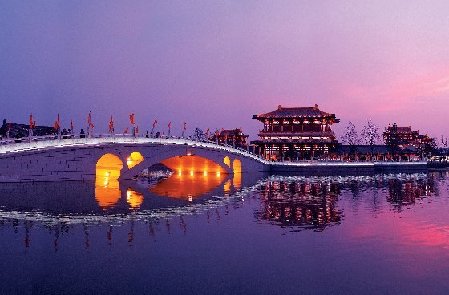The History of Xi'an
It is no exaggeration that Xian is the first choice if you are willing to find the longest history of China. This region is one of the vital birthplaces of the profound Chinese civilization. Benefiting from the fertile land and comfortable climate in ancient time, the rulers of 13 dynasties have set up their capitals in Xian successively. Thus, Xian is one of the cities which preserve a wealth of historical heritages in China.

Prehistory
The Lantian Man, which was found in Lantian County of Xian, has inhabited in this land about 800,000 years ago. The founded skulls fossils is said to be the earliest and best preserved ones in China until now. Coming to 300,000-400,000 years ago, the primitive people around Xian have turned into the stage of primitive clan communes gradually. The base of this region's agricultural production should be started when the Banpo Man made living here about 6,000 years ago. They have settled down in the eastern suburban of Xian City, setting up the Matriarchal clan villages.
In the Slave Society
The slave society of China mainly refers to the periods of the Xia (21st-16th century BC), Shang (16th-11th century BC), Western Zhou (11th century BC-771BC) as well as Spring and Autumn Peroid (770 BC-476). During this long history, more and more nations have immigrated to the Guanzhong Plain the center of which is just current Xian. Therefore, both of this region's economy and political system has gained rapid development. Until to the Western Zhou Dynasty, the Wenwang have moved the capital-Fengjing to the west bank of the Fenghe River nearby Xian. It played as the dynasty's religious and cultural center. Later, his heir Wuwang built the political center on the east bank of the Fenghe River, namely, Haojing. This should be the first recorded dynasty founded the capital in Xian City.
In the Warring State Period (476BC-221BC) and the Qin Dynasty (221 BC-206 BC)
Coming to the end of the Eastern Zhou Dynasty, namely, the Warring States Period, there mainly distributed seven powerful states in China. Qin, one of the seven states, was located in the center of Shaanxi Province and east Gansu Province. Later, Ying Zheng, Emperor Qin Shi Huang, set up the first feudal dynasty in Xianyang (consists of current Xian and Xianyang cites) after unifying the other six states. Although this dynasty fallen soon, a great number of historical relics were left, for example, the so famous Terra-cotta Warriors and Horses. Until now, some traditions and cuisines from the Qin Dynasty are still kept by the Xian locals.
In the Han Dynasty (206 BC-220)
The Western Han Dynasty (206 BC-24AD), which is the third dynasty setting up its capital in Xian, constructed its capital -Chang'an on the relics of the Qin's Xianyang. Once, Chang'an City was the largest one in the world, covering an area of about 36 square kilometers (13.9 square miles). Now, the site of the Weiyang Palace is preserved well in Xian. The famous 'Silk Road' which starts from the Chang'an City appeared during the period of Wudi, opening the communication between China and overseas countries. On the other hand, the emperors carried out a series of policies to help the rehabilitation of the people. The Chang'an became a thriving city both in economy and polity in the world wide.
|

